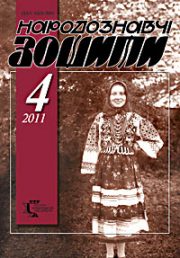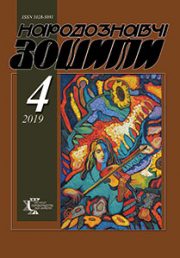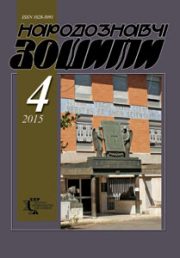The Ethnology Notebooks. 2023. № 2 (170), 324—342
UDK: 355.1-057.36(477)+355.1-057.36(470+571)]:004.77
DOI https://doi.org/10.15407/nz2023.02.324
RYABCHENKO Olga
- ORCID ID: https://orcid.org/0000-0002-1249-2482
- Doctor of Science (History), Professor,
- Head of the Department of World History,
- H.S. Skovoroda Kharkiv National Pedagogical University,
- 29, Alchevsky str., 61002, Kharkiv, Ukraine,
- Contacts: e-mail: lerche555@ukr.net
Abstract. Internet memes, along with other concise genres of discourse of modern means of mass communication, confidently conquer the digital space, turning into a socially important communicative unit. They are understood as repetitive and highly intertextual multimodal images and texts. In accordance with the growth of their popularity, the interest of scientists in this phenomenon of modern mass culture is also growing.
The article analyzes the peculiarities of the formation of images of the Armed Forces of Ukraine and russian troops in memetic constructions from the beginning of the full-scale war of russia in Ukraine until recently and the semantic characteristics that form the image of soldiers of the Armed Forces of Ukraine and enemies; it is tracked what kind of information turned into memes and how it happened; the most effective stories are singled out in terms of the speed of their distribution and audience preference on the Internet.
As a spontaneous product of mass culture, an instant reaction of people to some news or event, memes effectively influence the formation of an image of both the russian army and the Armed Forces of Ukraine. One of the most common storylines in memes is the attitude towards the aggressor and its army. In creating the image of individual russian soldiers and the army as a whole, an important place is occupied by stylistic devices, in particular epithets, metaphors, comparisons, thanks to which the enemy appears to the reader as funny and even ugly, its command is weak, and the army has lost the image of the second in the world and invincible, and began to be perceived as a gathering of marauders and an army of shame. This is reinforced by the visual range — the use of photographs, scenes from famous films, works of art or humorous images, as well as color and font. In contrast to the defamation and dehumanization of the image of the enemy army, memes and comments under them glorified our heroes, our Armed Forces.
Internet memes are the latest powerful tools of information warfare, political PR technologies, and military propaganda, as they strongly influence our consciousness. On the one hand, they are an element of war that can be compared in strength to the most powerful propaganda. On the other hand, memes provide emotional support, contribute to increasing the confidence of Ukrainians in victory over the enemy, and help overcome the traumatic burden of wartime.
The research used memes collected by the author from the beginning of the full-scale invasion of the troops of the russian Federation into Ukraine and until recently in various Ukrainian social networks.
Keywords: russian-Ukrainian war, memes, russian troops, ideological image, Armed Forces of Ukraine.
Received 17.03.2023
REFERENCES
- Burman, J.T. (2012). The misunderstanding of memes: Biography of an unscientifіc object, 1976—1999.Perspectives on Science, 20 (1), 75—104.
- Staub, V. (2021). Das Selbstmordattentat im Bild Aktualitat und Geschichte von Martyrerzeugnissen. Berlin [in German].
- Smola, L. (2019). Meme as a tool of information warfare. Visnyk Kyivskoho natsionalnoho universytetu imeni Tarasa Shevchenka. Psykholohiia, 1 (10), 91—96 [in Ukrainian].
- Chemerkin, S. (2015).Internet meme — what is it? Kultura slova, 82, 113—116 [in Ukrainian].
- Chaplak, Ya., & Chuyko, G. (2022). The specificity of memes in the Internet space of modern society. InterConf, 95, 337—350. Retrieved from: https://doi.org/10.51582/interconf.19-20.01.2022.035 [in Ukrainian].
- Kuzmenko, О. Something about ukrainian folklore from a new historical era of the struggle for independence. Retrieved from: https://www.koreanjournalofukrainianstudies.com/post/something-about-ukrainian-folklore-from-a-new-historical-era-of-the-struggle-for-independence?fbclid=IwAR3QYUwIWAxe_NPIVeoqy8I3BVUNLF_CoPAxwA-HF9tHJUjRUO-ytKdg8UA.
- Kuzmenko, О. (2022). Russians in Ukrainian Folklore from the 20th and Early 21st Centuries: The Dynamics of the Images and Contexts. Tautosakos darbai, 64, 15—56.
- Yekelchyk, S. (2022). Naming the war: Russian aggression in Ukrainian official discourse and mass culture. Canadian Slavonik Papers (Vol. 64, issue 2—3, pр. 232—246).
- Morenets, S. (2017, april 10). Laughter in the name of truth: wow, and you know all about memes. Retrieved from: https://ostroh.info/publications/tsikave/smih-v-imya-istyny-vzhuuuh-vy-znayete-vse-pro-memy/ [in Ukrainian].
- Adams, P. How Ukraine is winning the war in social networks. BBC News, Kyiv. Retrieved from: https://vpolshchi.pl/yak-ukrayina-peremagaye-u-vijni-v-social-nih-mere-6823900408666944a [in Ukrainian].
- Stelmashova, U. (2022, october 6). Igor Solovei: The best information tactic to deter Russians is fear, photos of dead bodies have a sobering effect. Retrieved from: https://spravdi.gov.ua/igor-solovej-krashhoyu-informaczijnoyu-taktykoyu-strymuvannya-rosiyan-ye-strah-foto-trupiv-mayut-vytverezuyuchyj-efekt/ [in Ukrainian].
- Papakin, H. (2022, 4.04.). Army of Russia: the beginning of the path of shame and crimes. 18th century. Retrieved from:https://day.kyiv.ua/uk/blog/istoriya/armiya-rosiyi-pochatok-shlyahu-ganby-i-zlochyniv-xviii-st?fbclid=IwAR2ghwSW7bU0orURVHFJbyy2zE08lpOiOU_IkeNP_EoBm2lrpJkKCEobo6o [in Ukrainian].
- (2022, december 2). Ukrainian memes! The weapon that Putin fears more than HIMARS. ICTV TV channel. VIDEO. УКРАИНСКИЕ МЕМЫ! Оружие, которое ПУТИН боится больше, чем HIMARS — YouTube [in Russian].
- Ocheretyana, T. (2022, march 5). The army of the Russian Federation is not strong, but long. Arestovych told how the Ukrainians are destroying the occupiers. Retrieved from: https://ukraine.segodnya.ua/ua/ukraine/armiya-rf-ne-silnaya-a-dlinnaya-arestovich-rasskazal-kak-ukraincy-raznosyat-okkupantov-1606943.html [in Ukrainian].
- The Russian army is not strong. It’s just long. Retrieved from: https://twitter.com/UkrArmyBlog/status/1512685542 462394368 [in Ukrainian].
- Kosharska, O. (2022, september 11). Counteroffensive, 50 thousand and invincible Armed Forces: a selection of memes about the war. Retrieved from: https://vsim.ua/Podii/kontrnastup-50-tisyach-ta-neperemozhni-zsu-dobirka-memiv-pro-viynu-11677907.html.
- Audergon, A. (2005). The War Hotel: Psychological Dynamics in Violent Conflict. London and Philadelphia: Whurr pablishers LTD.
- Dedyulina, O. (2022, march, 20). Why Russian invaders in Ukraine are called orcs. Retrieved from: https://od.vgorode.ua/ukr/news/sobytyia/a1200980-chomu-rosijskikh-okupantiv-v-ukrajini-nazivajut-orkami# [in Ukrainian].
- Orlova, V. (2022, february 28). «Palyanitsa — not a strawberry»: the Ukrainian Armed Forces «burned» another saboteur. VIDEO. Retrieved from: https://www.unian.ua/war/palyanicya-ne-polunicya-vsu-spalili-shche-odnogo-diversanta-video-novini-vtorgnennya-rosiji-v-ukrajinu-11721934.html [in Ukrainian].
- Orlova, V. (2022, march 29). VIDEO. Retrieved from: По ло нений окупант «Чмоня» став новим інтернет-мемом (відео) — УНІАН (unian.ua) [in Ukrainian].
- Yakubova, L. (2022, march, 19). Anatomy of racism. Ukrainian week. Retrieved from:https://tyzhden.ua/World/254578?fbclid=IwAR3SJSSquG9_J1MvyhneyzCAlHpwA3tg83f0dd5BoZ2HvDRxflvvFzSKK1o [in Ukrainian].
- (2022, october 27). Fresh chmobiki are arriving in the Zaporizhzhia region. Zaporizhzhia news. Retrieved from: https://mig.com.ua/u-zaporizku-oblast-prybuvaiut-svizhenki-chmobiky/ [in Ukrainian].
- Shumytska, G., Pidkuymukha, L., & Kiss, N. (2022, november 14). Language as a «bairaktar», language as a code: to the anniversary of the sociolinguist Larisa Masenko. Radio Svoboda. Retrieved from: https://www.radiosvoboda.org/a/larysa-masenko-ukrayinska-mova/32126052.html [in Ukrainian].
- Gulevata, T. (2022, april 7). Russian military marauders became «heroes» of caricatures (photo). Retrieved from: https://telegraf.com.ua/ukr/lifestyle/2022-04-07/5701714-rossiyskie-voennye-marodery-stali-geroyami-karikatur-foto [in Ukrainian].
- Ilyuk, K. (2022, june 20). Russian propaganda is largely built on the principle of «the fool himself». Retrieved from: https://ms.detector.media/propaganda-ta-vplivi/post/29676/2022-06-20-kseniya-ilyuk-rosiyska-propaganda-znachnoyu-miroyu-pobudovana-na-pryntsypi-sam-durak/ [in Ukrainian].
- (2020, july 25). Asked the prisoner from Sverdlovsk: «What are you doing here?». Interview with the judge of the Supreme Court of Ukraine, currently the platoon commander of the 93rd separate mechanized brigade, Ivan Mishchenko, VIDEO. Retrieved from: https://www.youtube.com/watch?v=wKxOvOXrfXk [in Ukrainian].
- Ustymenko, E. (2022, february 28). How to recognize the occupier without a «burner»: TOP-5 simple questions that are incomprehensible to a Russian. Retrieved from: https://apostrophe.ua/ua/news/society/2022-02-28/kak-uznat-okkupanta-bez-palyanits-top-5-prostyih-voprosov-neponyatnyih-russkomu/260897 [in Ukrainian].
- (2022, february 26). How to identify a rashist who pretends to be a local (MEM). Retrieved from: https://texty.org.ua/fragments/105782/yak-vyznachyty-rashysta-yakyj-vydaye-sebe-za-miscevoho-mem/ [in Ukrainian].
- (2022, march 19). «Chornobaivska raznia» in Internet memes of Ukrainians. Retrieved from: https://armyinform.com.ua/2022/03/19/chornobayivska-riznya-v-internet-memah-ukrayincziv/?fbclid=IwAR0caYGD17WzIuResWzuCqc8pZzqnBugnyjzzyzhjWUtPwzwVu1zTaxHlVo [in Ukrainian].
- Krechetova, D. (2022, march 19). «See Chornobayivka and die»: the reaction of Ukrainians to the defeat of the occupiers. Retrieved from: https://life.pravda.com.ua/society/ 2022/03/19/247884/ [in Ukrainian].
- (2022, september 11). Even if you don’t go to sleep, we’ll wake up, and we’re already near Moscow: how Ukrainians rejoice with memes about the successes of the Armed Forces and the whining of the Russians. Retrieved from: https://tsn.ua/ato/hoch-spati-ne-lyagay-prokinemosya-a-mi-vzhe-pid-moskvoyu-yak-ukrayinci-memami-radiyut-uspiham-zsu-ta-nittyu-rosiyan-2154961.html [in Ukrainian].
- (2022, march 6). War Geese and Biolabs: Why Russia Spreads Fakes About Ukraine. Retrieved from: https://uatv.ua/uk/bojovi-gusy-ta-biolaboratoriyi-navishho-rosiya-poshyryuye-fejky-pro-ukrayinu/ [in Ukrainian].
- (2022, august 13). Fighting geese, bees, goats and more: how nature fights on the side of Ukraine against the Russian occupier. Retrieved from: https://dnister.in.ua/articles/229280/gusi-bojovi-bdzholi-kozi-ta-ne-tilki-yak-priroda-voyuye-na-boci-ukraini-z-rosijskim-okupantom- [in Ukrainian].
- Bozhenko, A. (2022, august 5). «Gypsies stole a tank». The head of the Nikopol district explained the harm of memes about a stupid enemy. Retrieved from: https://glavcom.ua/country/society/tsihani-vkrali-tanka-holova-nikopolskoho-rajonu-pojasniv-shkodu-memiv-pro-durnoho-voroha-865649.html [in Ukrainian].
- Perun, V. (2022, march 25). In the Poltava region, the police seized 11 tanks from residents, as well as machine guns, rifles, grenades and several thousand rounds of ammunition. Retrieved from: https://lb.ua/society/2022/03/25/511045_poltavshchini_politsiya_viluchila.html [in Ukrainian].
- (2022, may 16). «300 tanks were preparing to force Psel»: how the «Hadyatsky Safari» on the border of the Poltava region was destroyed by the elite army of the Russian Federation. Retrieved from: https://www.telegraf.in.ua/topnews/10107014-300-tankiv-gotuvalisja-forsuvati-psel-jak-gadjacke-safari-na-kordoni-poltavschini-znischilo-elitne-vijsko-rf.html [in Ukrainian].
- Dobryak, A. (2022, april 21). Hadiac safari — how it was. Retrieved from: https://zmist.pl.ua/publications/gadyaczke-safari-yak-cze-bulo [in Ukrainian].






